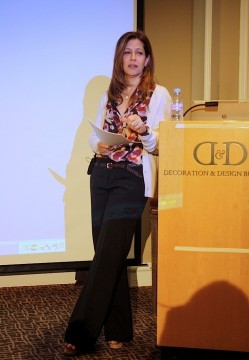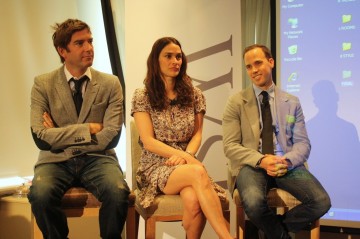There wasn't an empty seat in the house, or at least Astra Café, for the DDB's Spring Market keynote with The Wall Street Journal, What's Next in Decorating? Editor in Chief of WSJ Magazine Deborah Needleman hosted the expert panel consisting of Sara Ruffin Costello, WSJ Columnist; David Netto, WSJ Contributing Editor and Decorator; and Miles Redd, Decorator.
Deborah didn't tease the audience by simply asking the questions, and first began with her honest opinion of the idea of 'trends,' which is arguably the first thing many of us think of when asking what is next for design.

"I have to be honest and confess that I really hate 'trends.' I really feel that they are manufactured in an office and they aren't authentic at all. Nobody buys complete new sets of furniture every season and we don't run for new paint when Pantone tells us the color isn't teal anymore. However, there is a zeitgeist taking place, there's this feeling in the air around 'style leaders,' because they are the genuine leaders of 'trends.'”
And with that, Deborah introduced her panel of industry leaders who happen to be her close friends—all of whom conveyed a singular devotion to the industry.
Deborah began by asking where each of the panelists personally sought inspiration.

"I find the most inspiration in the great rooms of the great decorators throughout history," said Sara. "I look for the bold strokes they take. The 'big moment' that happens in a fabulous room is what design in all about—it’s the surprising drama of a home. Mark Hampton has his big moment in every room by finding the perfect piece of masculinity in an otherwise feminine room. Janet de Botton is another who always has that big moment, like covering the entirety of a room's walls with shelved plates!"
"For me, I'm now finding inspiration in color and shades," Miles said. " I look at artists, fashion and color and it just gets me when it's fresh and reminiscent of nature. I've always loved and condoned color blocking with the primary colors-you can add the three to any room and it will be a good decision."
"I'm most interested in the point of view of objects and how they relate to industrial design and architecture," said David. "Dorothy Draper is an example of being fearless in design in the 30's and 40's and it's just so brilliant how fearless she was. I think everything looks better just slightly unfinished. I love handmade, and a more ‘primitive modern’ lately. I'm in love with the 30's; that's my inspiration."

After being repeatedly quipped by David for clicking through his slides too quickly, Deborah got back to business and asked the panel what they have been especially loving for a while, but may also need to get rid of because of loving it too much or for too long.
"If I love something once, it's hard to get rid of it... I've just never been a hater!" said Miles. "I do love seeing restraint though, saying 'no' is very appealing to me."
David backed-up Miles by noting, "As you learn to decorate—which takes years—you learn to use less, which is harder."
"Jackie O'Nassis is a perfect example of using restraint," Miles continued. "She had the balls to put a drafting table in her living room because she knew she wouldn't use the room unless she could do her watercolors there!"
Stay tuned to GoDesignGo to hear more of What's Next in Decorating. Sara confesses who she wishes she were the 'love-child' of, David tells us what he can't stop loving in design and Deborah asks the panel what kinds of design and technique they're each sick and tired of.

No comments:
Post a Comment